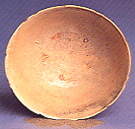 |
| Turiang |
12 May 2001
|
|||
| Last modified: 12 May 2001 |
 |
 |
 |
All of the Vietnamese ceramics discovered so far on the Turiang are bowls. The size range is limited: they are 14.5-17cm in diameter and 5.5-7cm high. Most are underglaze black, and decorated in similar fashion with a stylized chrysanthemum flower at the interior bottom, a stylized calligraphic or chevron scroll inside the rim, and another within line borders around the outside wall. The side of these bowls is S-shaped; the rims are straight and thin. The off-white clay is fine, smooth enough that no slip was required, although some had a chocolate wash on the base. The little glaze remaining is thin and often olive-green. Most of these bowls have five triangular spur-disc scars in the lower interior. Foot-rings are thinly cut with a flat recess in the base.
Calligraphic scrolls represent the earliest known Vietnamese style, and are almost identical to the scrolls on the Sukhothai wares. The Vietnamese paintings however are made directly on the body. Bowls like these with an underglaze black floral decoration had appeared in Japan by AD 1331¹.
 Five
Vietnamese monochrome bowls have been recovered. Four are plain. One
has a delicate foliate rim, with impressed interior decoration. Eight panels
with Buddhist emblems surround an 8-petalled flower. The lower interior displays
five triangular scars from a five-legged spur-disc. The diameter of this bowl
is 16 cm. These bowls have traces of an original pale green glaze.
Five
Vietnamese monochrome bowls have been recovered. Four are plain. One
has a delicate foliate rim, with impressed interior decoration. Eight panels
with Buddhist emblems surround an 8-petalled flower. The lower interior displays
five triangular scars from a five-legged spur-disc. The diameter of this bowl
is 16 cm. These bowls have traces of an original pale green glaze.
In all, twenty-four Vietnamese bowls have been recovered, of which seven have
a chocolate wash on the base. The foot-rings on these bowls are different, squarely
cut, with a rather deep and flat recess in the base. The chocolate wash is characteristic
of Vietnamese ware but by no means exclusive; in combination with the creamy
clay, foot-rings, and decorative style, there is little doubt as to origin.
All of these are typical of central Vietnamese ware of the 14th century.
| Turiang overview | Maritime Asia homepage | Next: Chinese ceramics on board |